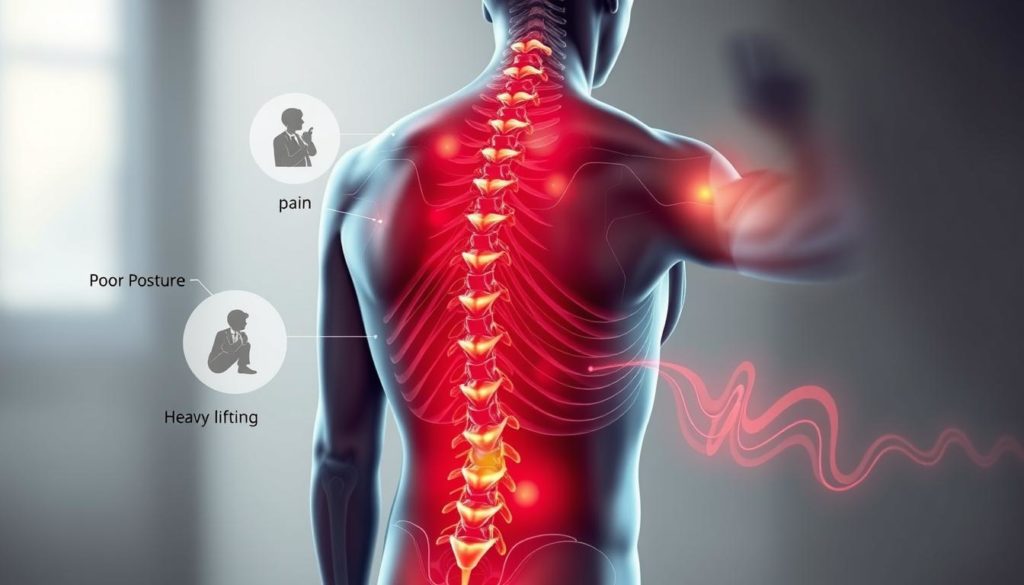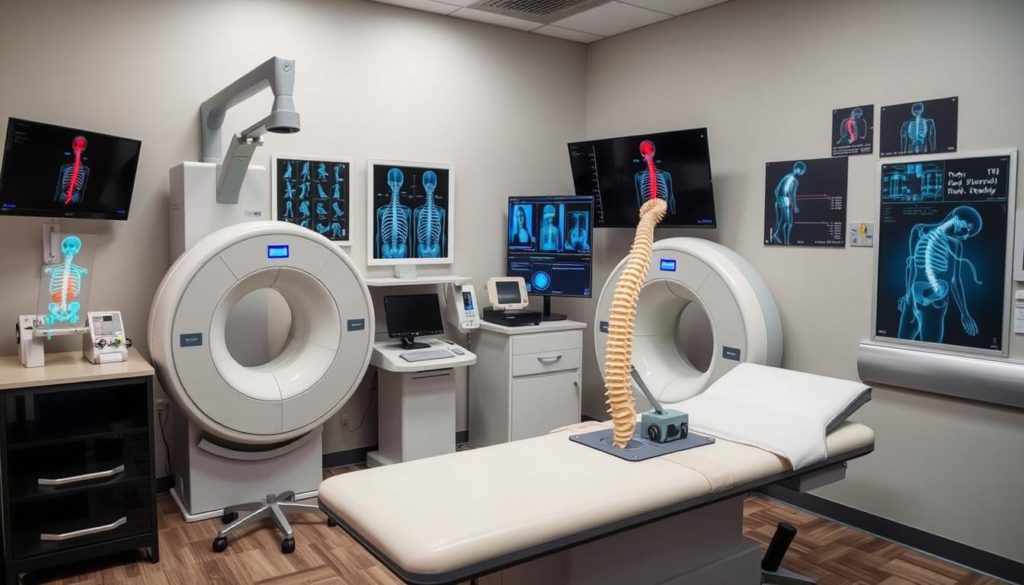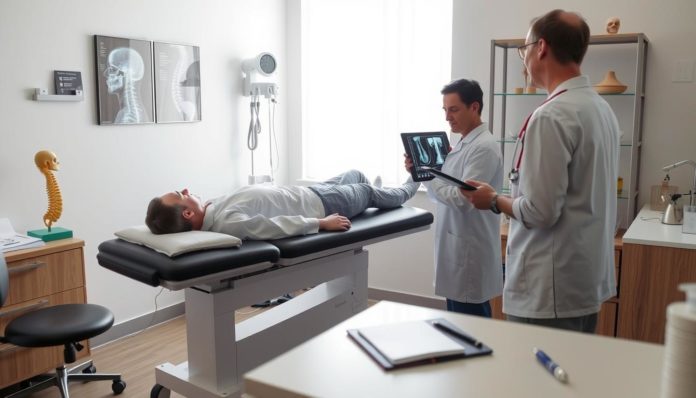Did you know over 31 million Americans have back pain at any time? This widespread issue highlights the importance of knowing how to check and handle back pain. Doctors look at how well patients can sit, stand, walk, and lift their legs. They also rate their pain from zero to 10.
This method pinpoints where the pain comes from and checks how it affects movement. It also finds muscle spasms and rules out serious problems. People are usually advised to stay active at home. They’re told to change how they do things to keep from making the pain worse.
Understanding Back Pain: Causes and Symptoms
Back pain arises from various factors like aging, disc problems, and muscle pain. Conditions such as spine arthritis and spinal stenosis can cause a lot of discomfort. It’s crucial to figure out why you have back pain to treat it right.

As we get older, we might face issues like degenerative disc disease and osteoarthritis. These are common reasons behind back pain. Also, spinal stenosis makes spaces within the spine tighter, squeezing nerves. This often leads to a lot of pain.
Disc problems, including herniation or bulges, often irritate nerves, causing severe back pain. If back pain stays for over three months, it’s called chronic. This type of pain needs a doctor’s look when usual treatments don’t help.
Here’s a detailed list of back pain causes, what you might feel, and how to tell if it’s acute or chronic:
| Cause | Symptoms | Back Pain Type |
|---|---|---|
| Spinal Stenosis | Leg pain, numbness, and difficulty standing | Chronic Back Pain |
| Herniated Disc | Sharp, radiating pain; muscle weakness | Acute or Chronic |
| Degenerative Disc Disease | Persistent lower back pain, worsens with activity | Chronic Back Pain |
| Myofascial Pain Syndrome | Localized muscle tenderness and pain | Chronic Back Pain |
Knowing what causes back pain and its symptoms is key to finding the right treatment. If you’re facing any of these problems, it’s smart to see a doctor. They can guide you on what to do next and help manage your pain well.
The Importance of Back Pain Testing Procedures
Back pain testing is key to finding and treating its causes. These tests let doctors pinpoint the source and severity. By using diagnostic tests, they can tell different causes apart, each needing its own treatment.
Detecting diseases like osteomyelitis or inflammatory arthritis is possible through these tests. It’s also crucial to rule out conditions that look like back pain, such as kidney stones or gastrointestinal diseases. This ensures patients get the right treatment.

There are many diagnostic tests for back pain, including imaging and lab tests. These help see if infections or inflammations are causing the pain. They guide doctors in choosing the right treatment.
Getting the diagnosis right means treatments can be tailored to each patient. Using the correct tests, healthcare providers can greatly improve patients’ lives. Those with chronic back pain can see better outcomes and quality of life.
Common Diagnostic Tests for Back Pain
Doctors use many tests to diagnose back pain accurately. Each one shows different details, which helps figure out the pain’s cause. This way, they can create the best treatment plan. Let’s look at these common tests.
X-Ray for Back Pain
An X-ray for back pain reveals the bones in the spine clearly. It’s great for spotting bone problems, like arthritis or breaks. This info is key for quick diagnosis and starting treatment.
MRI for Back Pain
An MRI for back pain is used for more detailed images. It’s top-notch at showing soft tissue problems, such as herniated disks or nerve issues. This thorough detail helps in evaluating the cause of back pain accurately.
CT Scans in Back Pain Diagnosis
Like MRIs, CT scans for back pain diagnosis provide detailed spine images. They’re great for seeing structural problems invisible in X-rays or exams. This makes CT scans vital for diagnosing back pain.
Blood Tests for Back Pain Diagnosis
Blood tests play a big role in back pain diagnosis, identifying infections or inflammation. They help uncover health issues that might worsen the pain.
Nerve Studies: Electromyography (EMG)
Electromyography (EMG) diagnoses nerve pressure issues. It measures nerve-made electrical impulses and muscle responses. EMG can spot conditions like herniated disks or spinal stenosis.
Physical Exam and Back Pain Assessment
Understanding and evaluating back pain starts with a thorough physical exam. This exam uncovers the pain’s source, nature, and intensity. It’s the first step towards creating a treatment plan that’s just right for you.
Evaluating Your Back Pain
During a back pain physical exam, doctors look closely at your symptoms. They want to know when the pain began, how bad it is, and what makes it worse. This detailed evaluation helps pinpoint the exact problem.
Assessing Muscle Spasms and Movement Limitation
Looking at muscle spasms and movement limits is key in assessing back pain. Doctors check your muscles and how well you can move, noting any spasms or tightness. This is crucial for a correct diagnosis and choosing the right treatment.
They also consider lifestyle, stress, and how active you are. These factors can affect back pain too.
- Lifestyle choices
- Emotional stressors
- Physical activity levels
Considering all these aspects makes the back pain exam thorough. It leads to a diagnosis that captures your unique situation. This way, your treatment is tailored just for you.
Role of Imaging in Back Pain Evaluation
The use of back pain imaging is critical in figuring out why people have back pain. With spinal imaging tests, doctors can see inside the spine. This shows details that you can’t find with just a physical check.
Imaging tests like X-rays, MRIs, and CT scans are key in back pain evaluation. They help spot issues like disk herniation and spinal narrowing. Knowing about these problems is key for planning the best care.
| Imaging Test | Purpose | Benefits |
|---|---|---|
| X-Ray | Basic structural assessment | Quick and widely available |
| MRI | Detailed images of soft tissues | Non-invasive and highly detailed |
| CT Scan | Cross-sectional images | High detail for bone injuries |
Spinal imaging tests put together a full back pain evaluation. They lead the way to care that’s just right for each person. These tests are not only for finding problems. They also check if the treatment is working well.
Advanced Back Pain Screening Techniques
In chronic back pain cases, standard images might not show everything. This is why advanced back pain screening is crucial. It gives clearer diagnostic details. Discograms and bone scans stand out, offering different but helpful information.
Discograms
A discogram examines the inside of a spinal disk. In this test, doctors inject dye into the disk. This helps capture clear pictures. It spots issues that MRIs or CT scans might miss. Knowing exactly where the pain comes from helps doctors create better treatments.
Bone Scans
A bone scan for back pain looks for bone problems. It can spot fractures, infections, or tumors. Doctors use a special dye to see bone activity. This way, they get details on what’s wrong. Bone scans improve diagnosis when used with other tests.
Learn more about these techniques at Mayo Clinic. Discograms and bone scans help find hidden back issues. They give doctors a full picture of the problem, leading to smarter treatment choices.
| Technique | Purpose | Advantages |
|---|---|---|
| Discogram | Assess internal disk structure | Pinpoints specific sources of pain |
| Bone Scan | Detect bone metabolism abnormalities | Identifies fractures, infections, tumors |
Back Pain Solutions: Home Treatments and Lifestyle Modifications
Dealing with back pain at home can change your life. Adding home treatments and changing your lifestyle can manage or relieve your pain.
Effective Home Remedies
Home remedies for back pain are easy but effective. Taking over-the-counter pain relief, using heat or ice, and doing gentle stretches can bring relief. Lifestyle changes, like improving your workspace and eating better, also help a lot.
When to Seek Professional Help
Home solutions are good, but sometimes you need a doctor. If pain lasts for weeks or stops you from doing everyday things, see a healthcare provider. They may offer stronger treatments, like prescription drugs or physical therapy.
| Home Treatment | Description | Benefits |
|---|---|---|
| Heat/Ice Application | Applying a heating pad or ice pack to the affected area. | Reduces muscle tension, swelling, and pain. |
| Over-the-Counter Pain Relievers | Using medications like ibuprofen or acetaminophen. | Alleviates mild to moderate pain. |
| Physical Activity | Engaging in gentle exercises and stretching. | Improves flexibility and strengthens muscles. |
| Ergonomic Adjustments | Modifying living and working spaces for better posture. | Prevents strain and promotes a healthy back. |
| Balanced Diet | Consuming a healthy, anti-inflammatory diet. | Aids in weight management and reduces inflammation. |
Medications for Back Pain Relief
To tackle back pain, we often turn to medications. You might use over-the-counter painkillers or maybe prescription drugs. These can be muscle relaxants or even antidepressants aimed at chronic pain.
Pain Relievers and Muscle Relaxants
Ibuprofen and acetaminophen are go-to drugs for back pain. They lessen inflammation and offer relief. When pain gets tough, doctors might prescribe muscle relaxants. Cyclobenzaprine helps ease muscle spasms.
Not everyone will find these drugs equally effective. It really depends on how severe the pain is and how your body reacts.
Topical Pain Relievers
Topical pain relievers are another path. You can apply creams or gels with menthol or capsaicin straight onto the sore spot. They target the pain right where it hurts, minus the side effects of pills.
Many people choose brands like Icy Hot or Biofreeze. They’re an alternative to swallowing medicine.
Use of Narcotics and Their Risks
In very severe pain cases, narcotics like oxycodone or hydrocodone might be the answer. But, these drugs come with big risks. They can lead to dependency and have other nasty side effects.
That’s why they’re only used for a short time. Always under a doctor’s careful eye.
The Role of Antidepressants in Back Pain Management
Antidepressants, such as duloxetine and tricyclic types, are effective against chronic back pain. They do more than just fight off depression. These meds actually make you less sensitive to pain.
This double action makes antidepressants a key player in treating long-term back pain. They’re part of a bigger plan to get you feeling better.
Non-Surgical Back Pain Treatments
Finding the right non-surgical treatments for back pain is key. These methods focus on easing pain without surgery. This means less risk and faster recovery. Physical therapy, alternative medicine, and injections are great ways to manage back pain.
Physical Therapy for Back Pain
Physical therapy is a top choice for treating back pain without surgery. It uses exercises to make back-supporting muscles stronger. Patients learn to move in ways that prevent future injuries. They might do manual therapy, exercise, and learn how to stand or sit better.
Exploring Alternative Medicine Options
There are many alternative treatments for back pain. Options include acupuncture, yoga, and TENS therapy. Acupuncture uses tiny needles to ease pain. Yoga helps by strengthening muscles and reducing stress. TENS therapy uses electric currents for pain relief.
Injection-Based Treatments
Injections are another way to deal with back pain without surgery. Treatments like epidural steroid injections help by lowering inflammation. Other injections can numb the pain area. These are often used with other treatments like physical therapy.
By using a mix of these non-surgical options, people can manage their back pain well. This helps improve their day-to-day life.
FAQ
What typically happens during a back pain examination?
Health care providers look at how you sit, stand, walk, and lift your legs. They use a scale from zero to 10 to understand your pain. This tells them how the pain affects your day and if there are muscle spasms or serious causes.
What are some common causes of back pain?
Back pain comes from different things like aging spines, spinal stenosis, and disk problems such as herniation. Sometimes, muscle pain is tied to myofascial pain syndrome. If back pain lasts more than three months, you might need to see a specialist.
Why are back pain testing procedures important?
Tests help find out the real cause and how bad your back pain is. This guides doctors in choosing the right treatment. They can find if conditions like infections or other diseases are causing your pain.
What can an X-ray reveal in back pain diagnosis?
An X-ray shows problems with bones like arthritis or fractures. It helps doctors see your spine’s structure to find possible issues.
How does an MRI help in diagnosing back pain?
MRI scans give a clear picture of your spine, showing issues with disks, muscles, tendons, and nerves. It’s vital for spotting problems that a physical check might not catch.
What role do blood tests play in back pain diagnosis?
Blood tests can show if infections or other conditions are causing your pain. They’re a key part of figuring out the exact cause to treat it right.
How is electromyography (EMG) used in diagnosing back pain?
EMG tests the electrical activity of nerves and how muscles respond. It helps confirm if nerve pressure from disk issues or spinal stenosis is causing pain.
What is involved in evaluating back pain during a physical exam?
The exam starts with looking at your symptoms and how they began. Doctors check for muscle spasms and how well you move. This helps them understand the pain better to plan your treatment.
How does imaging assist in back pain evaluation?
Imaging tools offer a detailed view of the spine. They can find problems like disk herniation or spinal narrowing. This guides doctors in choosing the best treatments.
What are discograms and how do they help in back pain screening?
Discograms check a disk’s inside to pinpoint pain sources. They’re used when regular scans don’t give enough info.
What are effective home remedies for back pain?
People find relief with painkillers, muscle relaxants, and applying heat. Changing your diet and how active you are also helps manage pain.
When should I seek professional help for back pain?
Get professional advice if home care doesn’t work, the pain lasts weeks, or it gets really bad. Doctors can suggest stronger treatments.
What medications are commonly used for back pain relief?
Treatments include NSAIDs, muscle relaxants, and creams. Sometimes, stronger painkillers are needed. Certain antidepressants are also used for chronic pain.
How can non-surgical treatments help with back pain?
Treatments without surgery, like therapy, can make muscles stronger and more flexible. Acupuncture, yoga, TENS, and injections are other options. They help alongside exercise and meditation to improve life quality.


